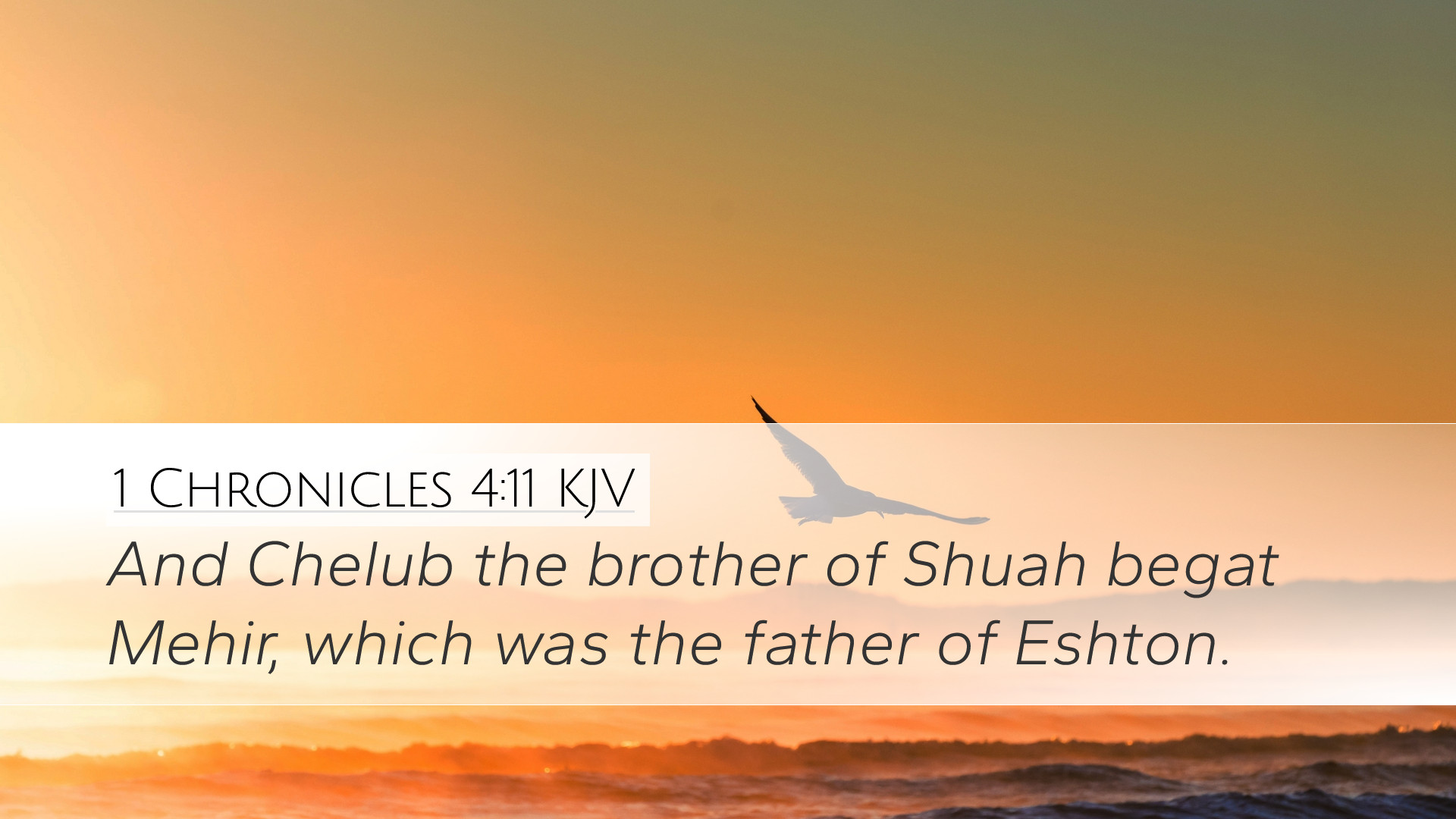Commentary on 1 Chronicles 4:11
Verse Reference: 1 Chronicles 4:11 - "And Chelub the brother of Shuhah begat Mehir, which was the father of Eshton."
Introduction
This verse, though seemingly simple, provides vital connections in the genealogies of the tribes of Israel. Genealogies often serve to highlight significant familial lines that contribute to the broader narrative of Scripture. Public domain commentaries, such as those by Matthew Henry, Albert Barnes, and Adam Clarke, offer valuable insights on this verse and its implications.
Understanding Chelub and Shuhah
Contextual Background: The genealogy presented in 1 Chronicles focuses on the descendants of Judah, one of the twelve tribes of Israel. This particular verse mentions Chelub as the brother of Shuhah.
- Matthew Henry: Chelub's identification as a brother to Shuhah highlights the close-knit nature of familial ties within the tribe of Judah. It signifies the importance of brotherhood in ancient Israelite society.
- Albert Barnes: He notes that genealogies were a matter of great significance to the Israelites, reflecting their heritage and God's promises to their ancestors.
- Adam Clarke: Adds that the mention of Chelub's progeny emphasizes the fulfillment of God's promise to bless Abraham's lineage, showing how specific families played crucial roles in the unfolding story of redemption.
Mehir and Eshton: A Lineage of Significance
The focus shifts to Mehir, the son of Chelub, and by extension, to Eshton, his descendant.
- Matthew Henry: Mehir is significant as he is linked with the line that will produce important figures in the history of Israel. The name "Mehir" suggests the idea of "one who sells" or "a dealer," indicating a potentially prosperous lineage.
- Albert Barnes: He points out the significance of Eshton, whose name could denote "the brooding place" or symbolize security and stability in the line of Judah.
- Adam Clarke: Highlights the continuous theme of God's providence and assurance of legacy within the genealogies. Each name represents not just individuals but the unfolding of Divine plans.
Theological Reflections
The genealogical sections of the Bible may often be overlooked, yet they are simply rich with theological truths.
- God's Faithfulness: The record of these names exemplifies God's faithfulness to His covenant. Every name represents a person through whom God worked to bring about His purposes.
- The Importance of Lineage: In Jewish culture, ancestry was crucial, denoting identity and responsibility. Understanding one’s genealogy often posed a sense of belonging within the community of faith.
- Christological Implication: The line of Judah leads directly to Jesus Christ, the Messiah, thus these names hold immense significance in tracing the fulfillment of promises made to Israel.
Applications for Today
As theologians, students, and pastors study this verse, they are called to consider the relevance of genealogy and legacy in their spiritual lives.
- Understanding Our Spiritual Heritage: Believers should appreciate their spiritual ancestry in the faith, recognizing how past generations have shaped their beliefs.
- Embracing Our Roles: Just as each ancestor played a part in God’s story, current generations are invited to fulfill their part in continuing the legacy of faith.
- Commitment to God’s Promises: This verse reminds us that God’s promises span generations. As we encounter challenges, it’s imperative to rest in the assurance of His faithfulness.
Conclusion
1 Chronicles 4:11 serves more than a historical purpose. Its genealogical nature reveals God’s intricate plan through generations and reminds us of our positioning within His great narrative. Believers today are encouraged to reflect on how they can contribute to the legacy of faith they have received.
In conclusion, through the insights of classic commentaries from Matthew Henry, Albert Barnes, and Adam Clarke, we find deeper understanding and rich implications of a verse that connects us to the story of redemption.


